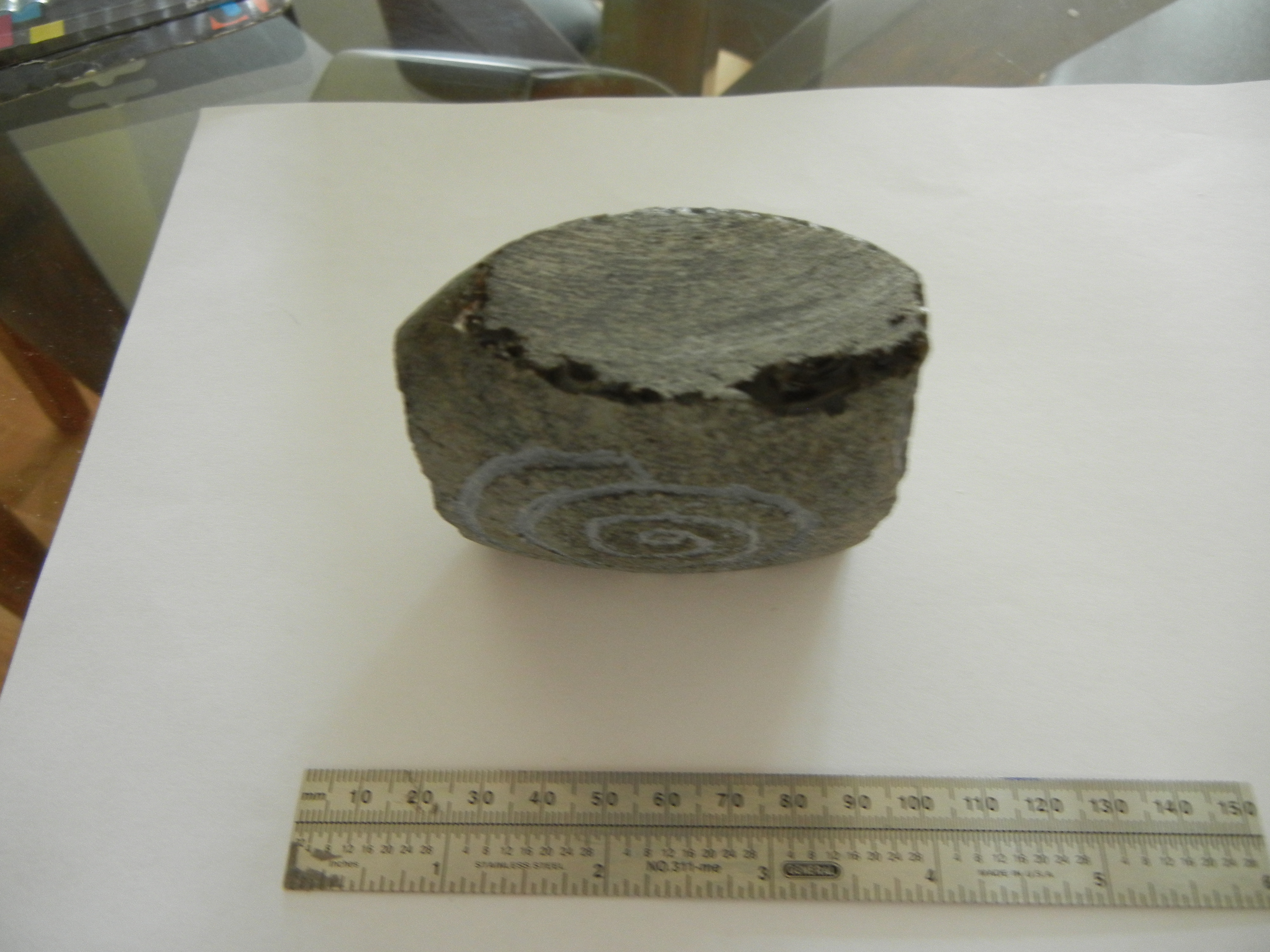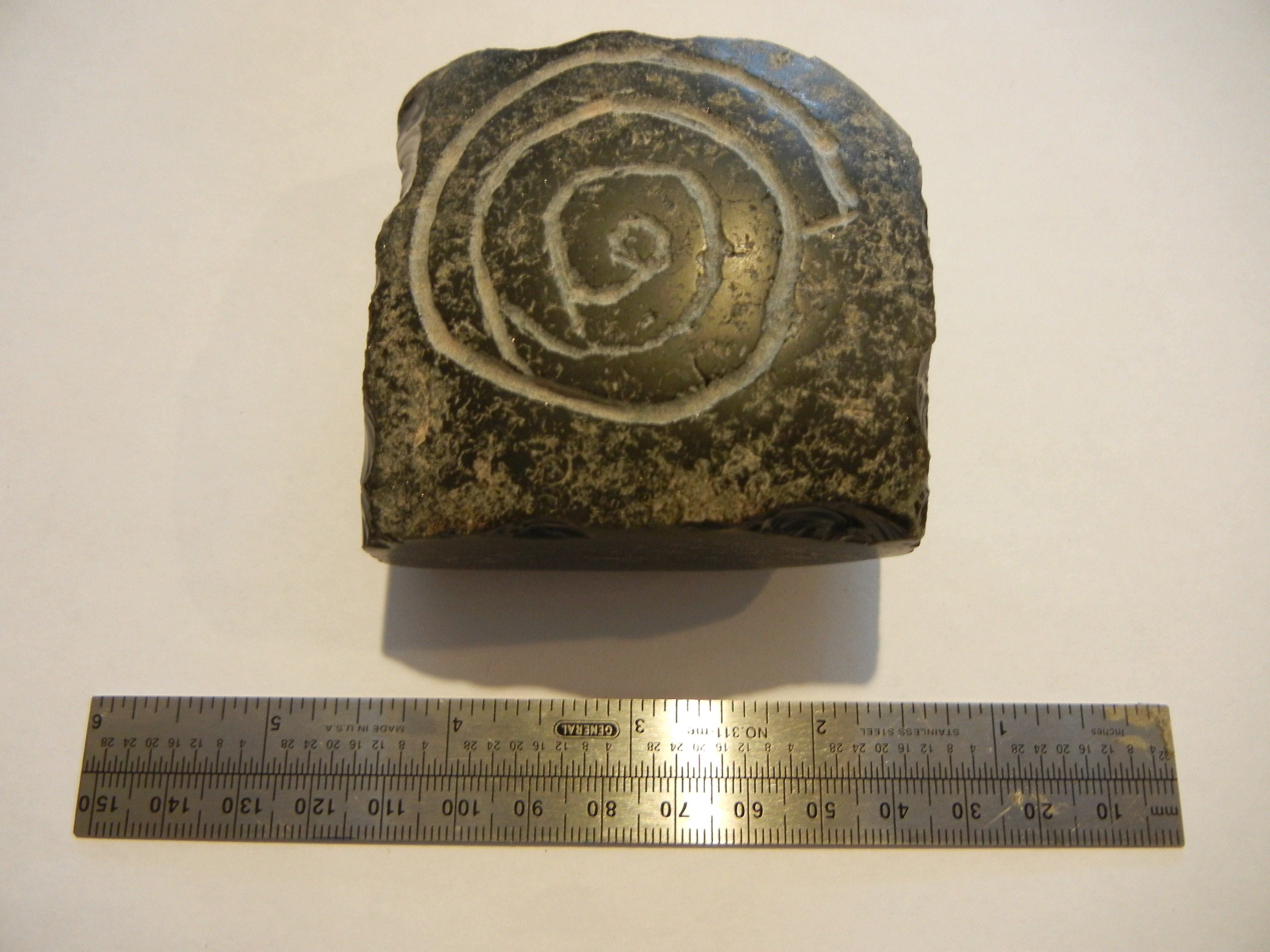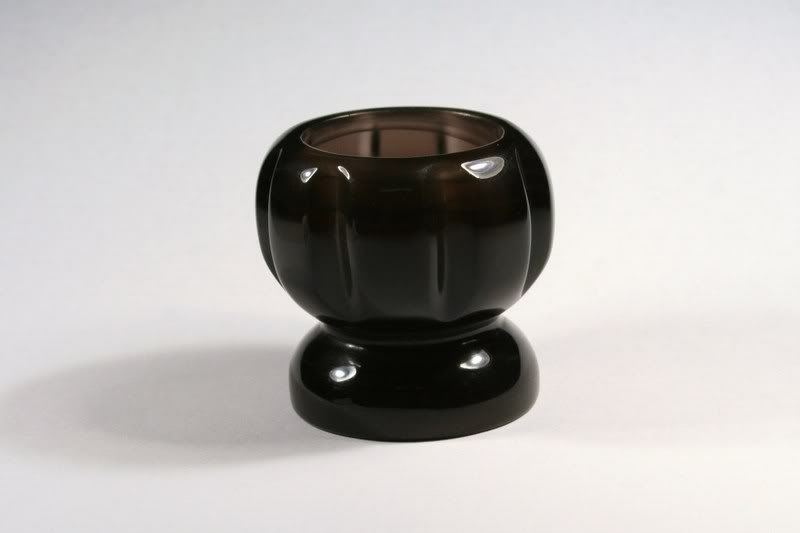trapperjohn
starting to shine!

Member since July 2019
Posts: 29
|
Post by trapperjohn on Jul 17, 2019 17:32:48 GMT -5
Continuing from my first post on the subject, I next set out to see what works best for polishing. as a reference here is my first cut on the rock:  Here is the same rock polished with a 120 grit flap wheel:  And here is one cut polished from 80 grit up to and including 1,000 grit:  Finally, here is the "spiral" surface, also sanded from 80 grip through 1,000 grit:  once again I stress that the total time invested in my polishing effort was about 20 minutes. With more attention to detail and better sanding tools (I used my oscillating palm sander) I think I can achieve the effect that I'm looking for. My conclusion thus far is that I can comfortably work with obsidian to carve my first ammonite. As always, comments, advice, and criticisms are appreciated if not required! |
|
|
|
Post by bobby1 on Jul 17, 2019 19:29:41 GMT -5
I work a lot with obsidian including cabochons, polished slabs and carving. It is very prone to chipping when you are using diamond burs or silicon grinding wheels such as the 1" Mizzy wheels. I do a lot of dry sanding (with the appropriate breathing masks) and it works great for getting the coarse grinding or saw marks out. I also use 1/2" wood dowels mounted on screw mandrels. I shape them with a coarse file and then wet them and roll them in various tumbling grits for sanding. I use the same wheels with cerium oxide for polishing. Here is a 1-1/2" high vase that I carved a few years ago. Bob  |
|
trapperjohn
starting to shine!

Member since July 2019
Posts: 29
|
Post by trapperjohn on Jul 17, 2019 20:17:54 GMT -5
First of all the vase is beautiful! There is much more to it than initially meets the eye, such as the fluting around the exterior. A real piece of craftsmanship!
I too dry sanded the piece that I am playing with. I always use a respirator regardless of the material I'm working with. I also always wear a full face shield, which may be overkill but it also keeps bits of rock shrapnel from hitting my face and most importantly, my eyes. I am quite sure that more time spent on removing the remaining saw marks out of the stone itself will work for me. I am not experienced in using cerium oxide but once again will use your good advice tomlearn about it and to try it out. I certainly will take it a bit more slowly and cautiously when I start on the "real" project.
Your self-designed sanding wheels are igeneous but I am having a bit of difficulty visualizing their final form. If you find the time to post a pic or two it would sure be appreciated! Thanks again, Bob!
|
|
|
|
Post by bobby1 on Jul 17, 2019 21:41:47 GMT -5
Here is a photo of the various wheel that I use in my carving. You can see the screw mandrels on the left. There are the Mizzy wheels, multiple shapes of polishing and sanding wood wheels and the various grinding wheels. Bob  |
|
|
|
Post by fernwood on Jul 18, 2019 3:13:53 GMT -5
bobby1 That is about the same as I have, minus the wood wheels. I also use cutting disks for some shaping. Find that they are more precise than the diamond bits. All of my felt polishing bits are stage specific. I store them individually in small zip lock bags. Labeled. Have not done much with carving yet, just cabbing. I want to carve some patterns onto cabs. trapperjohn This is an interesting project. Thanks for sharing. Looking forward to seeing the piece evolve.
|
|
trapperjohn
starting to shine!

Member since July 2019
Posts: 29
|
Post by trapperjohn on Jul 18, 2019 12:54:13 GMT -5
Well, I started out thinking that carving gemstones - obsidian, in my case - would require me to simply adapt my wood carving equipment and technique to a different material. I can see from the quality and detail that you have all provided that I need to broaden my perspective by learning a lot more about lapidary. To sum it up, here's what I've concluded this far:
1. I need to change my tools for slabbing. The diamond blade in the angle grinder worked well enough but the limitation of cut depth is a function of blade diameter and spindle size. A tile saw may be the answer here. I'd buy slabs but prefer to use my own found material.
2. I have the carving side under control as far as burs and basic equipment go but need to be more open to using cutting disks, as fernwood recently suggested.
3. I need to learn more about polishing tools and techniques. I understand the basics of how to work with wood; stone requires a different mindset. I rarely need grits finer than 400 when working with wood. Understanding Mizzy wheels, bobs, and hacks such as those suggested by Bob and others comes with experience and of course, advice.
4. While slabbing, cabochon work, and faceting are aspects of the art that I am not personally attracted to, learning more about grinding and polishing is essential to my progress. I will try to acquire enough reference material to avoid as many "newbie" questions as I can. Several of you have suggested good authors and sources for this.
Here's a final observation. When carving birds, study material is essential. As an example duck bills are cast in plastic for scalar reference as the bill is perhaps the only dimensional and proportional constant in determining size. Some people have even acquired several species of mounted ducks, which they regularly observe for detail when carving. Some have even created pens and habitat for live birds for the same purpose!
I have seen many pictures of ammonites, my intended carving, but have never actually observed a specimen. That will be changing. Also, while I come up my learning curve I'll continue to work with softer rock for practice.
Thanks once again for the valuable input!
|
|
|
|
Post by TheRock on Jul 18, 2019 18:53:32 GMT -5
trapperjohn it doesn't take you long to dig right in does it?  When I seen that Spiral Circular Pattern Design in pic 1,2,4 I thought I was watching Ancient Aliens with the NewGrange Kerbstone Anyway Lookin Good Daddy "O" Id like to learn that facet of this hobby but I'm going in to many directions already Il have fun watchin U. 
|
|
|
|
Post by hummingbirdstones on Jul 18, 2019 19:19:24 GMT -5
trapperjohn please feel free to ask all the "newbie" questions you have. We all started out asking the same questions. The folks on this board are more than happy to answer if they can.
|
|
|
|
Post by bobby1 on Jul 18, 2019 21:59:36 GMT -5
You might want to get a lapidary blade for your sawing. The one that you are using leaves a rather coarse pattern.
Bob
|
|
jasperfanatic
spending too much on rocks
 
Member since January 2019
Posts: 463
|
Post by jasperfanatic on Jul 18, 2019 23:30:52 GMT -5
I've touched little else except obsidian since April, just been living in it. Mostly cabs and specimen stuff, but just recently started trying to carve it using a dremel with a flexshaft and diamond burs. That's an interesting suggestion from bobby1 on the wood dowels and tumbling grit, going to have to give that a try because the rougher grit diamond burs chip too much for fine work. Thanks for that tip! I'll share what I'm doing on the polishing side to get perfect glassy finishes every time, which will apply to carving as well. I'm no expert and learn something new about this stuff frequently, but I have put a lot of time in which included banging my head against the wall to solve a few challenges. So, for what it's worth: 1. I always start on 220 grit. I'd rather knap a piece off or trim more with a saw than hit the 80 grit, polishing work took much longer whenever I did. 2. When cabbing I go 220 hard, 280 soft, 600 soft, 1200 soft and then super cerium. Could probably go from 600, but to me there is more clarity if I finish on 1200 before the CO. I've had the same experience using different tools but same grit sequence (specimen or carving). 3. Don't rush through the grits, make sure you get it all before moving on. You're gonna find out if you missed the mark eventually as you move up in grit and the scratches are screaming in your face, it's just more annoying when you discover it after 1200 or CO. I've done everything wet, which means drying it off well first to take a good look. Not sure if that changes when dry sanding, other than maybe washing any dust/residue off that could be filling scratches? trapperjohn We're in the same neck of the woods more or less and would be happy to connect up and help any way I could, as time allows. |
|
|
|
Post by TheRock on Jul 19, 2019 4:20:04 GMT -5
trapperjohn you may want to Contact David Clayton jadecarver.com he knows his stuff about carving. He also recommends a NSK Micromotor tool that is made for hard to carv material like Jade it spins up to 50,000 rpm and leaves the Foredom in the Dust. I have both and mine is a knock off I have a Maisilao Dental Lab and it spins up to 60,000 rpm and you have to ramp up the rpm if you start the bit at o to full speed it has so much torque it will bend the burr like a pretzel  All the Hot Shoe Carvers use these high speed machines to Carve Jade which is suppose to be hard to Carve I guess. Anyways All I know is another Member on here Rockoonz turned me onto Jade Carver and I have found his prices and knowledge to be very good. If you decide to get a Maisilao Dental Lab you can get one from Alibaba for $330.00 Way less than the $1800.00 Jade Carver Charges for the NSK Micromotor Tool or Ebay for the Maisilao Dental Lab. Good Luck Hope this Helps. 
|
|
|
|
Post by rockjunquie on Jul 19, 2019 10:19:41 GMT -5
I'm not sure if you mean you want to carve things that will LOOK like ammonites (spiral) Or, literally carve ammonites. But, I can say this- ammonites are very soft and unforgiving. They also have different hardnesses of soft. I would save that for when you are more experienced.
I see carving material on ebay all the time. They sell it for pipe making. I think some of it is called catlinite?
|
|
trapperjohn
starting to shine!

Member since July 2019
Posts: 29
|
Post by trapperjohn on Jul 19, 2019 13:02:52 GMT -5
Good points RJ. I should clarify that I am interested in carving replicas of ammonites. I agree that the original fossil material may be too soft for carving upon but that with the right skill that might be done. I've chosen obsidian for the challenge and because of its ready availability in my state. I also consider chalcedony of any type - jasper, agate, carnelian - to be materials to work with in time and I have successfully hunted for them in the past. Although sunstones are available I have no real interest in them.
I also want to thank The Rock for his advice on micromotors. I presently have a RAM micromotor tool and just replaced the handpiece with a dental quality unit. It has variable speed up to 50,000 rpm. I am not familiar with the Jade Carver but will look into the specs. I'll also look.at David Clayton's website as suggested.
Bob, your comments on polishing are also much appreciated. As I mentioned previously my sanding requirements thus far have not moved beyond 400 grit so I have to learn as I go here as well. I agree that my diamond blade is too thick. I am trying to figure out what blade to replace it with but find that I am juggling a lot of variables at once. That is why the advice of so many experienced folks is eagerly sought by me. Once you get to my age the irony of having lots of "spare time" (as in "retired") while not having quite so much time (as in getting old) starts to sink in!
|
|










 When I seen that Spiral Circular Pattern Design in pic 1,2,4 I thought I was watching Ancient Aliens with the
When I seen that Spiral Circular Pattern Design in pic 1,2,4 I thought I was watching Ancient Aliens with the 


 All the Hot Shoe Carvers use these high speed machines to Carve Jade which is suppose to be hard to Carve I guess. Anyways All I know is another Member on here
All the Hot Shoe Carvers use these high speed machines to Carve Jade which is suppose to be hard to Carve I guess. Anyways All I know is another Member on here 










